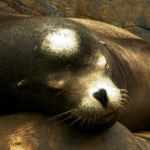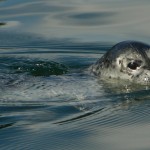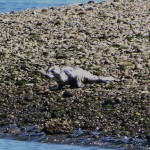What is the difference between a sea lion and a seal? And if there is a difference, why are the seals divided into three groups and not the sea lions? And why are some seals grouped into the same family with sea lions?
See the difference? Check out those external ears on the sea lion.
To begin with, all are Pinnipeds and there are three groups of these animals. Family Odobenidae, the Walrus family, makes up the third group. Since these giant pinnipeds are natives of the far north ice we won’t spend any time with them. Too bad, since they are fascinating animals, but there is a wonderful example at the Point Defiance Zoo in Tacoma, WA who puts on a charming show if you happen to be in the area at feeding time.
Your ads will be inserted here by
Easy Plugin for AdSense.
Please go to the plugin admin page to
Paste your ad code OR
Suppress this ad slot.
A baby harbor seal blends in very well with its rocky birthplace.
The word Pinnipedia comes from the Latin pinniped, meaning “feather footed.” Makes you wonder why they did not go with fin footed or flipper footed since all of these animals have front and rear feet modified into wide flippers. The eyes are relatively large and the external ear pinnas are either exceptionally small or missing altogether.
The Sea Lions and Fur Seals possess either very small ear pinna, or sometimes lack them completely. The front flippers are large and hairless, and the rear flippers are reversible; they can be positioned under the body for locomotion on land. The front flippers are larger and provide the main propulsion for swimming. Otariidae are medium to large sized pinnipeds and are found in all oceans except the North Atlantic and Indian Oceans. Males are noticeably larger than females (extreme sexual dimorphism).
The Earless Seal family, Phococidae, are small to very large seals. All lack an external ear pinna and have large, almost bulging eyes. Both flippers are fur covered; the front flippers smaller than the rear flippers, so it is the rear flippers that supply most swimming power in Furs seals. The rear flippers are not reversible, however, and makes land transportation a much more difficult proposition for these animals. The front flippers of the Phococidae are positioned closer to the front of the body than those of the Otariidae. Males are larger than females, but not nearly to the extent of the Otariidae.
None of our Northwestern pinnipeds can be considered small. At 100 pounds the female Northern Fur Seal is about as little as they get, yet even in this species males reach 600 pounds. Our undisputed champion in the heavyweight division is the male Elephant Seal, a true giant with weight in excess of two tons. Stellar Sea Lions tip the scales at more than 2,000 pounds and the 900 pound California Sea Lion is right behind. Pacific Harbor Seals appear small when only their head protrudes above water, but a 200 to 300 pound body is hiding beneath the waves. For more information on Harbor Seals go to this link: Harbor Seal Observations. In the article I detail some of the interesting things I’ve learned by watching this very common pinniped.
Pinnipeds are not only a fun species of Northwestern wildlife to observe, they are also the easiest ocean mammal to observe. They are regular inhabitants of marinas (some, in fact, become a real nuisance to boat owners) and are usually spotted on any ocean boating excursion. I cannot recall a single day when I’ve been out in the Sound and have not seen at least one.




Leave a Reply
You must be logged in to post a comment.